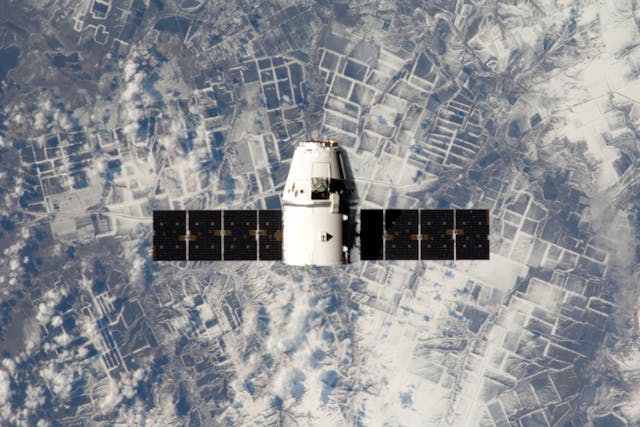
Have you ever wondered how people living in different continents talk on mobile phones? How does Google Maps guide you through the narrowest street? How do you get to watch live cricket matches from anywhere in the world? All of these things are possible with satellites. In this article, we will tell you what are satellites used for, what different types of satellites are, and why satellites are important. But before we answer any of these questions, let us tell you what a satellite is.
An artificial satellite is a device created and launched into orbit by humans. Natural satellites also exist, orbiting around larger celestial bodies in space. E.g., our planet Earth moves around the sun. Hence, it is considered a satellite and, since the moon orbits the Earth, it is also a natural satellite.
The space houses several satellites that facilitate several operations taking place on Earth. These satellites take pictures of Earth and other bodies in space, circulate TV signals, detect weather conditions, and more.
Besides the primary distinction, i.e., natural and man-made, satellites are also classified on the basis of their functions. They are-
As their name suggests, these satellites give us a detailed account of Earth’s surface, oceans, and atmosphere. The data collected by these satellites is used as the basis for monitoring weather and climate changes on Earth.
These satellites facilitate one-way and two-way communication.
GNSS (Global Navigation Satellite System) and PNT (positioning, navigation, and timing) are navigation satellites that gather location and time information and transmit that to the people on Earth.
Astronomical satellites observe stars and galaxies.
We use several satellite services throughout the day without even noticing. If you are wondering what do satellites do, let us tell you what are satellites used for.
Satellites play a crucial role in TV broadcasting by transmitting signals over vast distances. The ground station sends signals to the satellite in space (uplink). The satellite then amplifies those signals (satellite relay) and sends them back to the Earth (downlink). Satellite dishes receive these signals.
Satellites enable long-distance communication through telephones. The signals (which is actually your voice when you call someone) reach the satellite from the ground station (uplink). The satellite then sends these signals down to the ground station situated close to the receiver (downlink). This is how voice, video, and data reach the other person.
From small businesses to large enterprises and banks, every entity is dependent on satellites for smooth operations.
Banks use satellites to control all transactions and credit card authorization. The automated banking services are also supported by satellites.
By ensuring smooth audio and video communication, satellites help businesses to communicate and manage inventory and logistics.
Satellites orbiting the Earth constantly monitor the atmosphere, clouds, and oceans and capture images. They send the data regarding the storm movements, wind patterns, temperature, and humidity to weather stations. This real-time information helps in predicting weather conditions.
Satellites can monitor land from space and provide us with vital information about the changes that go unnoticed by us. They measure the temperature of the land and water, detect resources sitting underneath the land, keep a check on soil erosion, track water contamination, etc.
Furthermore, they can also monitor large infrastructures.
Considering these use cases, we can say that satellites are important to streamline our day-to-day activities. They help in every aspect, from entertainment to work.
Read further to discover the importance of satellites in our daily lives.
Global Positioning System or GPS is a satellite-based system that helps us determine our location and navigate on land, air, and water.
GPS satellites send signals with their location and time. These signals are received by a GPS receiver (fitted in our phones, smartwatches, car navigation systems, commercial and emergency vehicles, ships, boats, aircraft, and drones). The receiver receives signals from multiple satellites, determines the time taken by each signal to reach the device, and calculates the exact position based on it.
Satellites monitor dense forests, deep oceans, and wind currents. They capture any deflection from normal and send this information to the Earth, enabling prompt action. From high ocean currents to wildfires, oil spills, earthquakes, pollution, and storms, they alert us about everything.
Furthermore, the communication and navigation services also help to implement emergency response smoothly. They enable smooth communication in remote areas during search operations and monitor the movements of aircraft and ships to prevent accidents.
We communicate with the help of satellites. If there are no satellites, we might never be able to make calls to our dear ones sitting across oceans, see them through video calls, or transfer any data. Satellites help us stay connected to our loved ones and to the rest of the world through telephones, televisions, and the internet.
Our defense services require real-time information to guard us from any danger lingering on land, sea, or air. Satellites help military and defense organizations keep track of every movement. They use the data captured by satellites to plan their strategies and protect us from any danger.
Satellites aid development by enabling communication services in remote areas. They facilitate easy access to medical services and education in areas where people are often bereft of mere essentials.
They also help countries in resource management.
Satellites play a pivotal role in our regular lives and help to create a safer and smarter tomorrow. We hope this article has given you a clear understanding of what are satellites used for.
If you want to learn more about satellites, you can learn about them through CBSE skill education. DWPS Barasat offers a comprehensive course on satellites as a part of the CBSE skill education initiative.